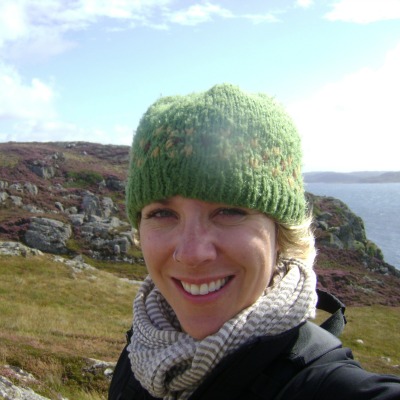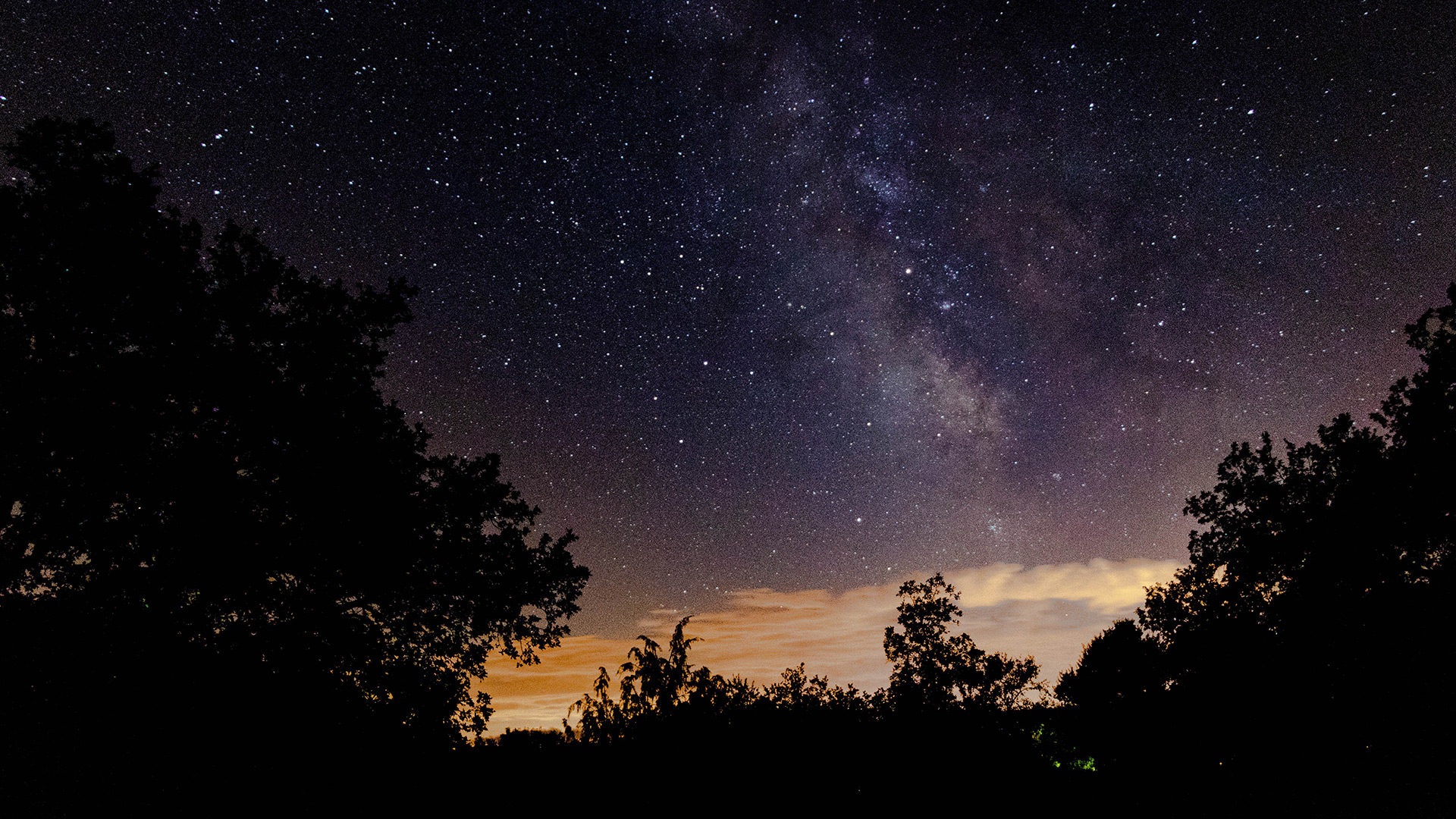I can still see the Big Dipper when I wake early enough. The city’s din of lights are quiet and there is a silence with its own kind of pre-dawn chorus. Even in the aurora of my urban context, I encounter the matins of a howling pack of Coyotes; the low honking of a gaggle of Canadian Geese; and the commuting caw of a murder of Crows. I remember where I am because of the presence of the more than human world around me.
Walking early one morning with the cloak of night still around me, I looked up into the sky expecting the familiar and storied orientation of the North Star, Sagittarius, and Scorpius, and saw something that instead stopped me in my tracks: a string of starry pearls moving in formation were stretched out in an evenly straight line over my head. For the two minutes that I observed this celestial sequence I lost the sense of knowing where I was; the stars were shifting and so was I. It wasn’t until days later that I learned that I had witnessed the 23rd mission of Starlink satellites, a satellite internet constellation being constructed by Elon Musk’s SpaceX that will consist of over 42,000 satellites that will provide near-global internet coverage of the populated world in 2021.[1] A whole new artificial constellation is being created in the cosmos.
What happens to our deeper sense of knowing when you can no longer distinguish the stars from the satellites? What happens to our storied sense of the sky when it shifts? Will we still see Andromeda chained to a rock or Hercules slaying a lion? Or in North American Indigenous communities, will they still find their bears, sweat lodges, and thunderbirds in the sky? How will we still know who we are when the cosmos converts?
“We lose our souls if we lose the experience of the forest, the butterflies,
the song of the birds, if we can’t see the stars at night.”
—Thomas Berry
The storied stars are part of how Indigenous people all over the world have made sense of the world around them. But more than that, it has provided people a sense of place and a bone-deep knowing of belonging to this Earth and the community of creation. These celestial stories have helped humans make meaning of the natural world and understand its variable features. It is within the night sky that we are reminded of our sacred evolutionary cosmology: that we too are made of stardust!
Stars are our birthright and connect us to a cosmic kinship. Stars that go supernova are responsible for creating many of the elements of the periodic table, including those that make up the human body. Planetary scientist and stardust expert Dr. Ashley King explains: “It is totally 100% true: nearly all the elements in the human body were made in a star and many have come through several supernovas.”[2] When we look up at the stars, we are reminded of our stellar ancestry and of our own storied existence, ultimately receiving guidance for our journey through life on this planet.
Star navigation has been used by seafarers for millennia. For thousands upon thousands of years, Aboriginal and Torres Strait Islander peoples have navigated their way across the seas and lands of Australia using paths called songlines or dreaming tracks.[3] Songlines will often follow on from one another, creating an intricate oral map of place, linking important sites and locations that exist in the outer world to their inner world, their soulscape. The soil and the stars become the medium by which one knows where they are, and when we know where we are, we know who we are.
“Tell me the landscape in which you live, and I will tell you who you are.”
— José Ortega y Gasset
In the Hebrew Old Testament scripture of Jeremiah, we encounter a journey that guides Israel back to her city, to her homeland, the place of her belonging. In Jeremiah 31:21 there is a command to set up way marks, collected items from the natural world believed to likely be heaps of stones, or pole-like trees, put upon the path to guide the traveler through wild and spacious landscapes.[4] Here there is a sense that the natural world is coming alongside the pilgrim to provide guidance, wisdom, and a sense of direction towards a place of belonging. Stones, trees, and stars are in place to offer both guidance as well as meaning; they are meaning-makers, subjects that are offering a sense of our storied existence and insight into how we make our way upon this planetary home.
This world, like the night sky, is dramatically changing, however. Trees that once were there to mark our way, have been chopped down; deforestation occurring the world over at a rate of 10 million hectares annually.[5] Stones that sat and offered sacred guidance for millennia in the shapes of mountains are being removed for coal surface mining. With these way-markers gone, people are existing separately from an increasingly degraded world, moving through memories of resplendent places, which are quickly evaporating.
We are forgetting the wonder-filled world that used to guide us and tell us where we are, and why we are. Our sense of our self, along with our imagination of the Sacred, is being desecrated along with the land. With ongoing environmental degradation at local, regional, and global scales, people’s accepted thresholds for environmental conditions are continually being lowered and storied landscapes are being forgotten.
In the absence of oral traditions, nature-based myths, or personal experience with historical environmental conditions, members of each new generation accept the landscapes (and starscapesǃ) in which they are raised as being normal. This psychological and sociological phenomenon is termed shifting baseline syndrome (SBS), which is increasingly recognized as one of the fundamental obstacles to addressing a wide range of today’s global environmental issues.[6] I would suggest it has huge implications on our soul formation as well.
Consequences of SBS include an increased tolerance for progressive environmental degradation, changes in people’s expectations as to what is a desirable (worth protecting) state of the natural and wild world, and the establishment and use of inappropriate baselines for nature conservation, restoration and management. It also creates a general malaise and environmental amnesia for the interconnection between the more than human world and our own human existence. At the same time, for those who are connected to the memory of a place, ecological grief can set in as sacred stories seem to dissipate under the bulldozer’s blade.
How do we survive wandering in this kind of desolate wilderness? When we re-story our lives, we restore not only ourselves, but the land upon which we live as well. It is a way to quite literally, save ourselves—hear in this resilience—and the more-than-human world. Reverence, interconnectedness, service, and solidarity are the keys that help us unlock the prison of our false sense of separation and fortify our resilience in this world. A flourishing future is possible through recovering a reconnection between people and their place.
Jeremiah offers us insight into the Divine impulse that desires restoration. We can participate in this meant-for-pattern by engaging in rewilding efforts, restoration endeavors that bring landscapes, and soulscapes, back into whole interrelationship with all of creation, including the cosmos. Ecotheologian Thomas Berry wisely stated that, “The universe is composed of subjects to be communed with, not objects to be exploited. Everything has its own voice. Thunder and lightning and stars and planets, flowers, birds, animals, trees, all these have voices, and they constitute a community of existence that is profoundly related.”
Our planetary home needs us to remember its wild wonder, to reconnect to the voices that are singing praises all around us, to restore the stars with stories of our sacred ancestry, not satellites. And if we can commit to this rewilding work, we may yet have hope that we will witness the manifestation of the dawn chorus’ morning prayer: that humanity will experience peace by finding their belonging here and will join with the choir of creation, singing the lines that lead us all home.
Read more from Mary DeJong on Christ & Cascadia.
Sources
[1] Yan Huang, Michelle, Bob Hunt, and Dave Mosher. “What Elon Musk’s 42,000 Starlink satellites could do for—and to—planet Earth.” Business Insider, March 4, 2021 https://www.businessinsider.com/how-elon-musk-42000-starlink-satellites-earth-effects-stars-2020-10
[2] Kerry Lotzof, “Are We Really Made of Stardust?” National History Museum https://www.nhm.ac.uk/discover/are-we-really-made-of-stardust.html (accessed March 30, 2021).
[3] Beau James, “Songlines: The Art of Navigating the Indigenous World,” Australian National Maritime Museum, Sydney, Australia, Australian Government, May 31, 2016. https://www.sea.museum/2016/05/31/songlines-the-art-of-navigating-the-indigenous-world (accessed March 30, 2021).
[4] Jeremiah 31:21 (Revised Standard Version)
[5] The State of the World’s Forests 2020 Report; Food and Agriculture Organization of the United Nations.
[6] Masashi Soga, and Kevin J. Gaston. “Shifting baseline syndrome: causes, consequences, and implications,” Frontiers in Ecology and the Environment, Volume 16, Issue 4 (May 2018), 224.


